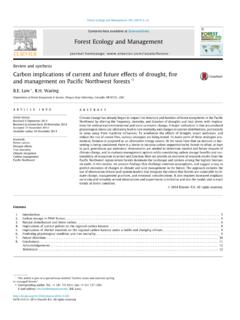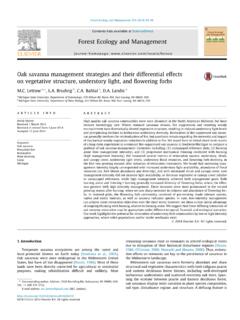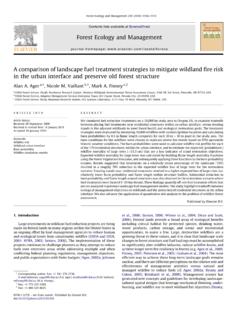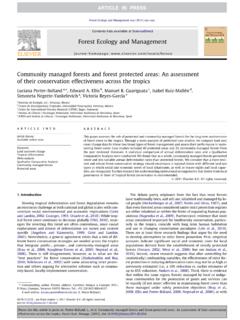Transcription of Forest Ecology and Management - Colorado State University
1 Forest Ecology and Management xxx (2014) xxx xxx Contents lists available at ScienceDirect Forest Ecology and Management journal homepage: Climate change impacts on re regimes and key ecosystem services in Rocky Mountain forests Monique E. Rocca a, , Peter M. Brown b, Lee H. MacDonald a, Christian M. Carrico c a Department of Ecosystem Sciences and Sustainability, Natural Resource Ecology Laboratory, Colorado State University , Fort Collins, CO 80523-1476, USA. b Rocky Mountain Tree-Ring Research, 2901 Moore Lane, Fort Collins, CO 80526, USA. c Department of Civil and Environmental Engineering, New Mexico Institute of Mining and Technology, Socorro, NM 87801, USA. a r t i c l e i n f o a b s t r a c t Article history: Forests and woodlands in the central Rocky Mountains span broad gradients in climate, elevation, and Available online xxxx other environmental conditions, and therefore encompass a great diversity of species, ecosystem productivities, and re regimes.
2 The objectives of this review are: (1) to characterize the likely short- Keywords: and longer-term effects of projected climate changes on fuel dynamics and re regimes for four generalized Rocky Mountains Forest types in the Rocky Mountain region; (2) to review how these changes are likely to affect carbon Climate change sequestration, water resources, air quality, and biodiversity; and (3) to assess the suitability of four Fire regime different Management alternatives to mitigate these effects and maintain Forest ecosystem services. Prescribed re Ecosystem services Current climate projections indicate that temperatures will increase in every season; forecasts for precipitation are less certain but suggest that the northern part of the region but not the southern part will experience higher annual precipitation. The increase in temperatures will result in a greater proportion of winter precipitation falling as rain, earlier spring snowmelt, and a consequential increase in the length and severity of re seasons.
3 Fire frequency is likely to increase in the short term in all areas because of the warmer, longer, and drier re seasons, but this change is likely to lead to a longer-term reduction in vegetation productivity in some of the most moisture-limited Forest types, such as pi on-juniper and lower montane. This will decrease fuel accumulation rates and consequently reduce re risk and result in longer re return intervals. We consider four main Management alternatives: re suppression, wild re (no intervention), prescribed re, and mechanical thinning. The paper summarizes the effects of these treatments on Forest ecosystem services, showing that they vary widely by Forest type. This broad-scale assessment provides general guidance for Forest managers and policy makers, and identi es more speci c research needs on how climate-driven changes in fuel production and Forest conditions will affect impact the four main Forest ecosystems across the central Rocky Mountain region.
4 2014 Published by Elsevier 1. Introduction water resources, air quality, and biodiversity; and (3) to assess the suitability of four different Management alternatives to mitigate Forests and woodlands in the central Rocky Mountain region of these effects and maintain Forest ecosystem services. In the rst Montana, Idaho, Wyoming, Colorado , and Utah encompass a broad section, we describe the general patterns of species composition, diversity of species, ecosystem productivities, community struc- community structure, re regimes, and land Management legacies tures, and re regimes. As a consequence of this diversity, climate for four broad Forest types: pi on-juniper woodlands, lower change is likely to impact the region's forested ecosystems in montane forests, upper montane forests, and subalpine forests. varied and complex ways. The objectives of this review are: (1) We then provide a conceptual model relating re regimes to to characterize the likely short- and longer-term effects of pro- climate.
5 Next, we summarize climate forecasts for the region and jected climate changes on fuel dynamics and re regimes for four use the conceptual model to project how re regimes in the four generalized Forest types in the Rocky Mountain region; (2) to Forest types are likely to change in both the short and long term, review how these changes are likely to affect carbon sequestration, as these two different time scales may show different trends. Finally, we compare four Management alternatives re suppres- Corresponding author. Tel.: +1 970 491 2112. sion, wild re (no intervention), prescribed re, and mechanical E-mail address: ( Rocca). thinning in terms of their costs and bene ts for preserving or 0378-1127/ 2014 Published by Elsevier Please cite this article in press as: Rocca, , et al. Climate change impacts on re regimes and key ecosystem services in Rocky Mountain forests. Forest Ecol. Manage. (2014), 2 Rocca et al.
6 / Forest Ecology and Management xxx (2014) xxx xxx promoting carbon sequestration, water resources, air quality, and most favorable for pi on-juniper establishment and growth biodiversity preservation under possible future climate changes. (Romme et al., 2009). In these persistent woodlands, canopies The Rocky Mountain region encompasses a complex geologic may be open or closed, and understory vegetation is typically template with steep climatic and topographic gradients and sparse and discontinuous. Fires that burned across large areas were diverse soil substrates. Superimposed on this template are the leg- historically infrequent (ca. 300 500 year intervals) due to lack of acies driven by past climatic events, such as Forest establishment surface fuels; these typically took the form of stand-replacing pulses and natural disturbances such as insect attacks and re. crown res (Floyd et al., 2000), and probably required strong winds More recent legacy effects include land use change and land man- to burn across patchy fuelbeds.
7 Rather than re ecting past res, agement practices, such as logging, grazing, and re suppression. tree demography was likely determined by legacies of droughts Past re Management practices can greatly complicate efforts to and wet periods and, perhaps, on other disturbances such as bark project ecosystem response to future climate and re Management beetles (Romme et al., 2009; Heyerdahl et al., 2011). alternatives. For some Forest types re exclusion has caused pro- found changes in Forest composition, structure, type and amount Lower montane forests of fuel, and resulting re behavior. Dendroecological studies have provided abundant information on historical re regimes, and Lower montane forests in the Rocky Mountains are dominated these have helped de ne the historic ranges of variability in distur- by ponderosa pine (Pinus ponderosa). In the southern part of the bance processes and Forest conditions before widespread impacts region in Colorado and southeastern Utah, lower montane forests due to Euro-American settlement.
8 In many cases, Forest structure usually occur as either relatively pure stands of ponderosa pine has been altered to the point where longer-term re regimes are or ponderosa pine with some combination of species found in no longer operable without major ecological restoration efforts lower-elevation pi on-juniper woodlands or higher-elevation (Friederici, 2003). upper montane forests, especially Douglas- r (Pseudotsuga menzie- Given the broad goals of this paper, we necessarily have to sii). Gambel oak (Quercus gambellii) also is a common understory group Rocky Mountain forests into four broadly de ned Forest species across the southern lower montane zone. Lower montane types: pi on-juniper woodlands, lower montane forests, upper forests in Idaho and Montana consist of mostly ponderosa pine montane forests, and subalpine forests (Fig. 1). This classi cation or are co-dominated by Douglas- r or western larch (Larix occiden- allows us to provide an overall characterization, context, and con- talis).
9 Historically, lower montane forests also were characterized trast that is useful for Forest managers, decision makers, and the by diverse and productive understories, dominated by bunch public. By de nition we cannot capture all of the spatial complex- grasses, although in many areas, increased tree density and canopy ity and temporal history of Forest ecosystems across the Rocky closure since re exclusion has reduced the cover and diversity of Mountain region ( Rollins et al., 2002; Romme et al., 2009). understory vegetation. However, these four broad Forest types capture much of the vari- Prior to Euro-American settlement, re scars document surface ability among forests and re regimes in the region because of res every 3 30 years, depending on elevation, latitude, and envi- the wide range of climatic conditions, Forest structure, and Forest ronmental conditions ( Agee, 1993; Falk et al., 2011). Mature productivities represented by these four main Forest types.
10 It also ponderosa pine trees are well-adapted to surface res, with thick is important to recognize that a majority of the region is covered bark that protects growing tissues from girdling and high crowns by non- Forest ecosystems (Fig. 1). Some of the information and that lessen the possibility of crown scorch. Under the historical re analysis in this report may apply to grasslands or shrublands adja- regime, larger and older trees tended to survive most res, whereas cent to the forested ecosystems, but these ecosystems are not an seedlings and smaller saplings were usually killed. Crown res explicit focus of this review. Other less extensive Forest types, such were mostly limited to small patches. These passive crown res, as riparian forests, are not covered in this review, even though they where re spread was predominately through surface fuels, added may be especially vulnerable to climate change and re regimes.










